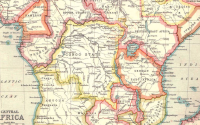1 November 2007Yahoo! NewsBogonko Bosire
The discovery of a new population of monkeys in Kenya, away from their normal habitat, could have been caused by climate change that may be affecting Africa, a conservation group warned Wednesday.
Kenyan conservationists discovered the De Brazza monkey population in the country's arid north, yet the species is largely known to live in the wet areas west of the Rift Valley, Nairobi-based Wild Direct said in a study titled "Primates in Peril."
While large populations of De Brazza's monkey, known for their white beards and shyness, exist in central Africa, the population in Kenya is low and under immense anthropogenic pressure.
"This latest discovery really underlines our ignorance of changes in the landscape over a relatively short period of time," said world-renowned Kenyan conservationist Richard Leakey.
"The De Brazza's must have had a wet forest corridor from western Kenya across the Rift Valley to this new locality," which is dry, Leakey added in a the statement issued by Wildlife Direct, a conservation panel he chairs.
"It is a critical issue for study as it puts climate change again as the most critical consideration as we plan for the future," warned Leakey, also famous for discoveries on human evolution and protecting rare mountain gorillas in central Africa.
Before the latest discovery, De Brazza's monkeys were not known to exist east of the Great Rift Valley, which is dry.
Although De Brazza monkeys live in riverine and swamp forests in the Congo Basin from southeast Cameroon to Equatorial Guinea and Angola, some are found in wet parts of western Kenya.
Researchers from Kenya's Samburu Primates Research and Conservation Project made the discovery after counting 162 monkeys in an arid range in the north in eight months.
The discovery boosts the species' population by 16 percent, up from the current 1,000 across Kenya.
"I was not expecting to find more than two to three groups. When I realized that there were such healthy populations existing in an unknown habitat, I was overwhelmed," said Iregi Mwenja, who has been studying the species in Kenya for four years.
The new discovery puts the species out of threat in Kenya, where it was facing extinction owing to human-wildlife conflict -- rampant deforestation and competition from other species, Wildlife Direct said in the statement.
"For the first time in Kenya we have a population that is stable and not under serious threat. Given that habitat loss is one of the biggest threats to species, finding a new habitat is a tremendous bonus and reminds us just how important every aspect of an ecosystem is," Mwenja explained.
De Brazza's Monkeys (Cercopithecus neglectus) is one of Africa's indigenous and most unusual species in the group of old world monkeys commonly known as guenons.
Scientists have warned that increased fossil fuel pollution would raise temperatures this century, worsen floods, droughts and hurricanes, melt polar ice and damage the climate system for a thousand years to come.
They say Africa would be worst hit by resultant global warming caused by the accumulation of heat-trapping gases in the atmosphere.
Kenyan activists are pressing environmental conservation, notably planting trees to help reduce the effects of climate change.






